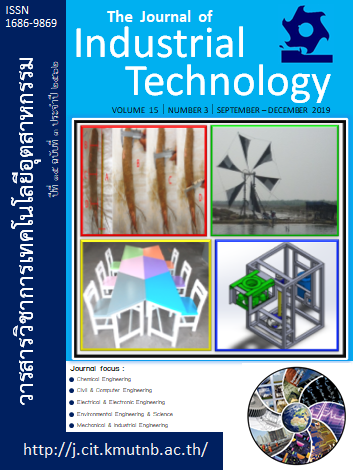(Prediction of Stress Relaxation Behavior of Closed-Cell Polymer foam Under Compressive Load)
Keywords:
Polymer foam, Stress relaxation, Loading rate, PredictionAbstract
Abstract
Recently polymer foam is mostly used in sandwich structures, an application of panel in container floors and airplane’s wings, by using the advantage of high strength to weight ratio property. In several of application difference loads are absorbed, materials can failure or unsafe to use if cannot relax old stress. The aims of this study are to study and predict the stress relaxation at various loading rates under the compressive load. The results of experiments on closed cell polyvinylchloride foam vary from 0.1 to 500 mm/min represented that difference loads effected to stress relaxation. Generalized Maxwell with Prony’s series are applied to predict stress relaxation behavior at 0.1 and 500 mm/min. The comparison results with actual test data found that both methods are indifferent and appropriate to replace the destructive method.
References
[1] A. Kraatz, M. Moneke and V. Kolupaev, “Long-Term Tensile and Compressive Behavior of Polymer Foams”, J. Cell. Plast 423, 2006, pp. 221–228.
[2] M.L Willains, R.F. Landel and J.D. Ferry, “The Temperature Dependence of Relaxation Mechanisms in Amorphous Polymers and Other Glass Forming Liquid”, Journal of the American Chemical Society, 1995.
[3] M. C. Saha, H. Mahfuz, U.K. Chakravarty, M. Uddin, Md. E. Kabir and S. Jeelani, “Effect of Density, Microstructure, and Strain Rate on Compression Behavior of Polymeric of Foams”, Materials Science and Engineering A 406, 2005, pp.328-336.
[4] G. Subhash, T. R. Walter, A. W. Richards, “A Unified Phrnomenological Model for Tensile and Compressive Response of Polymeric Foams”, Journal of Engineering Materials and Technology 131, 2005.
[5] V.L. Tagarielli, V.S. Deshpande and N.A. Fleck. “The High Strain Rate Response of PVC Foams and End-Grain Balsa Wood”, Composites part B: Engineering 39, 2008, pp. 83-91.
[6] P. Poapongsakorn and C. Kanchanomai, “Time-Dependent Deformation of Closed-Cell PVC Foam”, Journal of Cellular Plastics 47, 2011, pp. 323-336.
[7] B. Koohbor, A. Kidane and W.Y. Lu, “Effect of Specimen Size, Compressibility and Inertia on the Response of Rigid Polymer Foam Subjected to High Velocity Direct Impact Loading”, International Journal of Impact Engineering 98, 2016, pp. 62-74.
[8] A. Yoshimoto, H. Kobayashi, K. Horikawa and K. Tanigaki, “Effect of Strain-Rate and Temperature on Mechanical Behavior of Polyamide Foam in Compression”, Advance Publication by J-STAGE Mechanical Engineering Journal, 2016.
[9] G. D. Piero and G. Pampolini, “On the Rate-Dependent Properties of Open-Cell Polyurethane Foams”, TECHNISCHE MECHANIK 30, 2010, pp. 74-84.
[10] V. Kalyanasundarum and S. R. Holdsworth, “Prediction of Forward Creep Behavior from Stress Relaxation Data for a 10% Cr Steel at 600 ˚C”, Trans Indian Inst Met 69, 2016, pp. 573-578.
[11] J. Guo, H. Shi and W. Meng, “Prediction Methodology of Creep Performance from Stress Relaxation Measurements”, Applied Mechanics and Materials Vol.401-403, 2013, pp. 920-923.
[12] M.C. Saha, B. Barua, and A. Balakrishnan, “Stress Relaxation Behavior of Thermoset Polyurethane Foams”, Proceeding of SEM Annual Conference, 2009.
[13] M. C. Saha, B. Barua, “Incorporating Density and Temperature in the Stretched Exponential Model for Predicting Stress Relaxation Behavior of Polymer Foams”, Journal of Engineering Materials and Technology 138, 2016.
[14] S. Karaman, M. T. Yilmaz, O.S. Toker, M. Dogan, “Stress Relaxation/Creep Compliance Behavior of Kashar Cheese: Scaning Electron Microscopy Observation”, International of Dairy Technology Vol 69, 2016, pp.254-261.
[15] T.Chen, “Determining a Prony Series for a Viscoelastic Material From Time Varying Strain Data”, U.S. Army Research Laboratory, 2000
[16] F. Mainardi, G. Spad and A. Creep, “Relaxation and Viscosity Properties for Basic Fractional Models in Rheology”, The European Physical Journal 193, 2011, pp.133-160.
[17] M. Sadan, “Polymer Theory of Rheology”, Bangkok: Forepace Publish House, 1994. (in Thai)
[18] Z. Jia-lei, L. Zi-xing, “Numerical Modeling of the Compression Process of Elastic Open-cell Foams”, Chinese Journal of Aeronautics 20, 2006, pp. 215-222.
[19] A.G. Denay, S. Castagnet, A. Roy, G. Alice, “Creep Compression Behavior of a Polyurethane Foam From Cryogenic Temperatures: Size Effect and Long Term Predoction”, EPJ Web of Conference 6, 2010, pp.1-8
[20] L. J. Gibson and M. F. Ashby, “Cellular solids: Structure and properties (2 Ed)”, Cambridge University Press, 1997.
[21] M. Petru, O. Novak, “Measurement and Numerical Modeling of Mechanical Properties of Polyurethane Foam”, Intech open Chapter 4, 2017, pp.86-96.
[22] ISO 13314:2011 Mechanical testing of metals-Ductility testing – Compression test for porous and cellular machine.
[23] ASTM E328-13, “Standard test Method for Stress relaxation Test for Materials and Structure”, West Conshohocken, PA: ASTM International, 2013.
[24] ASTM D1621-15, “Standard Test Method for Compressive Properties of Rigid Cellular Plastic”, West Conshohocken, PA: ASTM International, 2000.


